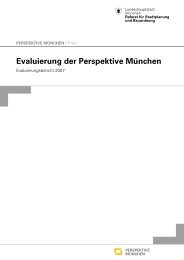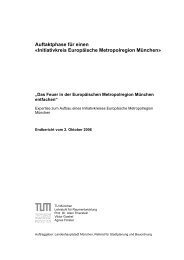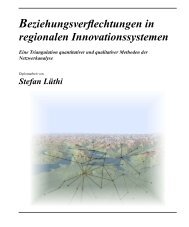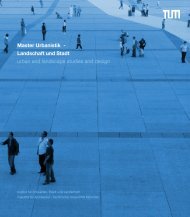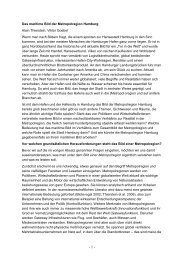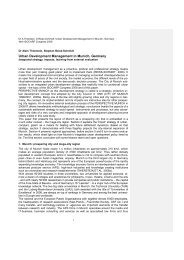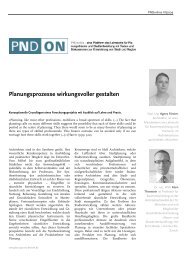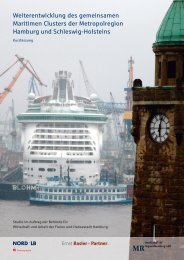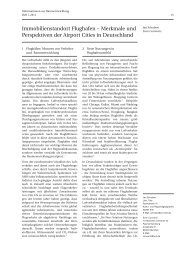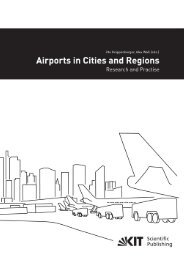0.6-1-Cover and Table of Contents-pp 0-05.indd - Raumentwicklung ...
0.6-1-Cover and Table of Contents-pp 0-05.indd - Raumentwicklung ...
0.6-1-Cover and Table of Contents-pp 0-05.indd - Raumentwicklung ...
Create successful ePaper yourself
Turn your PDF publications into a flip-book with our unique Google optimized e-Paper software.
MAHMOUD REZA SAGHAFI, JILL FRANZ, AND PHILIP CROWTHER<br />
Perceptions <strong>of</strong> Physical versus Virtual Design Studio Education<br />
refers to the pace <strong>of</strong> those activities, <strong>and</strong> the fifth<br />
is the main type <strong>of</strong> interaction for each activity.<br />
By reviewing each row, some aspects <strong>of</strong> each<br />
learning activities can be analyzed including<br />
a<strong>pp</strong>ropriate environment, time mode, pace <strong>and</strong><br />
type <strong>of</strong> the interaction.<br />
As can be seen, VDS is the a<strong>pp</strong>ropriate environment<br />
for studying the theme <strong>and</strong> for discussion, PDS<br />
for orientation <strong>and</strong> peer learning, <strong>and</strong> both<br />
environments for other activities. The analysis<br />
becomes more complex when considering the<br />
a<strong>pp</strong>ropriate time mode for the same activities<br />
<strong>and</strong> their a<strong>pp</strong>ropriate environments. For the<br />
eight activities which are achievable in both<br />
environments, five – orientation, peer learning,<br />
lecture, communication, <strong>and</strong> presentation –<br />
should be done in real time, while collaboration,<br />
designing, feedback, <strong>and</strong> assessment can be<br />
done in both time modes. However, studying<br />
the theme <strong>and</strong> discussion generally occur in<br />
asynchronous mode.<br />
The pace <strong>of</strong> synchronous activities is scheduled<br />
<strong>and</strong> other learning activities, such as asynchronous<br />
community-based activities, benefit from being<br />
mainly community-paced. The last column shows<br />
the dominant type <strong>of</strong> interaction in the activities.<br />
It has been recognised that designing <strong>and</strong> study<br />
<strong>of</strong> the theme are mainly based on studentto-content<br />
interaction; orientation, lectures,<br />
feedback, <strong>and</strong> assessment are mainly based on<br />
tutor-to-students interaction; <strong>and</strong> other activities<br />
benefit from student-to-student as their main<br />
mode <strong>of</strong> interaction.<br />
With this model, some sessions (including<br />
orientation in the first week) should occur in<br />
PDS to stimulate the development <strong>of</strong> a sense <strong>of</strong><br />
community, while some other aspects should be<br />
considered for VDS, optimising both <strong>of</strong>f-campus<br />
attendance <strong>and</strong> on-campus attendance. For<br />
instance, lecturing is a synchronous activity which<br />
can be achieved in both face-to-face <strong>and</strong> live<br />
online modes to provide access from anywhere.<br />
Contrary, discussion should be achieved in webbased<br />
mode (VDS), asynchronous, communitypaced<br />
<strong>and</strong> student-to-student interaction to<br />
maximise the effectiveness <strong>of</strong> learning.<br />
In addition to providing possible combinations <strong>of</strong><br />
the features for defining a particular a<strong>pp</strong>lication,<br />
this initial model can be used for analysing the<br />
characteristics <strong>of</strong> each learning activity in design<br />
education. Authors’ recent paper (2012) presents<br />
the final model <strong>of</strong> this study.<br />
Acknowledgment<br />
The authors would like to acknowledge the educators<br />
<strong>and</strong> students <strong>of</strong> architecture who have participated in<br />
the case study. Without their su<strong>pp</strong>ort, this study would<br />
not have been possible. In addition, we would like to<br />
make special mention <strong>of</strong> the su<strong>pp</strong>ort received from Paul<br />
S<strong>and</strong>ers, Yasuhiro Santo, Stephan Gard, <strong>and</strong> Nuno Dias.<br />
References<br />
Austerlitz, N., <strong>and</strong> Aravot, I. (2007). Emotions <strong>of</strong><br />
Architectures Students: A New Perspective for the<br />
Design Studio. In A. M. Salama <strong>and</strong> N. Wilkinson (Eds.),<br />
Design Studio Pedagogy: Horizons for the Future (<strong>pp</strong>.<br />
233-245). Gateshead: The Urban International Press.<br />
Bender, D. M., <strong>and</strong> Vredevoogd, J. D. (2006). Using<br />
Online Education Technologies to Su<strong>pp</strong>ort Studio<br />
Instruction. Educational Technology <strong>and</strong> Society, 9(4),<br />
114-122.<br />
Bennett, S., Maton, K., <strong>and</strong> Kervin, L. (2008). The ‘Digital<br />
Natives’ Debate: A Critical Review <strong>of</strong> the Evidence.<br />
British Journal <strong>of</strong> Educational Technology, 39(5), 775-<br />
786.<br />
Bersin, J. (2004). The Blended Learning Book: Best<br />
Practices, Proven Methodologies, <strong>and</strong> Lessons Learned:<br />
Archnet-IJAR, International Journal <strong>of</strong> Architectural Research - Volume 6 - Issue 1 - March 2012<br />
19



